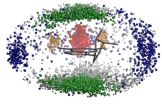(Press-News.org) Delivering life-saving drugs across the blood-brain barrier (BBB) might become a little easier thanks to a new report published in the November 2014 issue of The FASEB Journal. In the report, scientists describe an antibody, called "FC5," is one-tenth the size of a traditional antibody and able to cross the BBB. Moreover, FC5 uses the same pathways as nutrients that the brain needs to survive, allowing it to "smuggle" larger antibodies across the barrier. Like a Lego building block, FC5 connects into many types of antibody designs, helping them reach their disease targets in the brain. This research could lead the way for the development of new therapies to fight a wide range of brain diseases, such as Alzheimer's, Parkinson's, cancer, epilepsy, genetic brain diseases, neurodegenerative disease, chronic neuropathic pain, and other conditions.
"Neurological diseases are often devastating for both the affected person and their families. Current treatments are unsatisfactory and have many side effects, and the development of precise, new medicines has so far been unsuccessful because it is difficult or impossible to deliver enough medicine into the brain," said Danica B. Stanimirovic, Ph.D., a researcher involved in the work from the Human Health Therapeutics Portfolio at the National Research Council of Canada in Ottawa, Ontario. "With the technology developed in this collaborative work, we hope to open up opportunities for many promising treatments, including antibodies, against neurological diseases to be evaluated in clinical trials and eventually become available to patients."
To make their discovery, Stanimirovic and colleagues attached FC5 to a larger molecule in different configurations and then tested it in cell models and in rats to determine if it was transporting the larger molecules across the BBB. They also incorporated a peptide (a small protein) into the larger molecule being transported by FC5. This peptide was a pain-fighting molecule that cannot enter the brain by itself through the bloodstream. This FC5-peptide combination was injected into the bloodstream and the pain-fighting peptide crossed the BBB to reach the brain.
"The blood-brain barrier is such a robust security system that it should make today's computer programmers and engineers envious," said Gerald Weissmann, M.D., Editor-in-Chief of The FASEB Journal. "Unfortunately for us, this security system might be a little too good in the sense that it makes it extremely difficult to deliver drugs to the brain. This report may finally offer the key to unlocking a wide range of therapies that could dramatically improve millions of lives."
INFORMATION:
Receive monthly highlights from The FASEB Journal by e-mail. Sign up at http://www.faseb.org/fjupdate.aspx. The FASEB Journal is published by the Federation of the American Societies for Experimental Biology (FASEB). It is among the most cited biology journals worldwide according to the Institute for Scientific Information and has been recognized by the Special Libraries Association as one of the top 100 most influential biomedical journals of the past century.
FASEB is composed of 27 societies with more than 120,000 members, making it the largest coalition of biomedical research associations in the United States. Our mission is to advance health and welfare by promoting progress and education in biological and biomedical sciences through service to our member societies and collaborative advocacy.
Details: Graham K. Farrington, Nadia Caram-Salas, Arsalan S. Haqqani, Eric Brunette, John Eldredge, Blake Pepinsky, Giovanna Antognetti, Ewa Baumann, Wen Ding, Ellen Garber, Susan Jiang, Christie Delaney, Eve Boileau, William P. Sisk, and Danica B. Stanimirovic. A novel platform for engineering blood-brain barrier-crossing bispecific biologics. FASEB J. November 2014 28:4764-4778; doi:10.1096/fj.14-253369 ; http://www.fasebj.org/content/28/11/4764.abstract
New molecule sneaks medicines across the blood/brain barrier
New research in The FASEB Journal suggests that a very small single domain antibody called FC5 has proven able to cross the blood-brain barrier, which opens the door to new treatments for brain diseases
2014-10-30
ELSE PRESS RELEASES FROM THIS DATE:
Clock gene dysregulation may explain overactive bladder
2014-10-30
If you think sleep problems and bladder problems are a fact of life in old age, you may be right. A new report appearing in the November 2014 issue of The FASEB Journal, shows that our sleep-wake cycles are genetically connected to our bladder, and disruptions to one may cause problems with the other. This discovery builds on the hypotheses that under normal circumstances, a primary clock located in the brain controls several other peripheral clocks located throughout the body. These peripheral clocks, in turn, control the activity of functional proteins and receptors, ...
Patents for humanity: Special edition of Technology and Innovation
2014-10-30
TAMPA, Fla. (Oct. 30, 2014) – The current special issue of Technology and Innovation, is devoted to patents that benefit people around the world who live with limited resources, in challenging environments, and are in need of better access to basic needs and improved standards of living, health and infrastructure.
The issue includes original articles from winners of the 2013 USPTO Patents for Humanity Awards, aimed at rewarding innovators for deploying patented technologies to address humanitarian needs. Winners featured in the issue include SIGN Fracture Care International, ...
Lou Gehrig's disease study: Renewing brain's aging support cells may help neurons survive
2014-10-30
LOS ANGELES (Oct. 29, 2014) – Lou Gehrig's disease, also known as amyotrophic lateral sclerosis, or ALS, attacks muscle-controlling nerve cells – motor neurons – in the brain, brainstem and spinal cord, leading to progressive weakness and eventual paralysis of muscles throughout the body. Patients typically survive only three to five years after diagnosis.
Now, with publication of a study by investigators at the Cedars-Sinai Board of Governors Regenerative Medicine Institute, ALS researchers know the effects of the attack are worsened, at least in part, ...
Smithsonian scientist discovers populations of rare songbird in surprising new habitat
2014-10-30
The Swainson's warbler (Limnothlypis swainsonii) is one of the rarest and most secretive songbirds in North America, prized by birdwatchers in the southeastern U.S. hoping to catch a glimpse of it in the wild or hear its beautiful ringing song. With only 90,000 breeding individuals sparsely distributed across 15 states in the U.S., the Swainson's warbler is a species of high conservation concern that, for decades, has left conservationists with little confidence that its populations would ever be fully secure.
However, new research published in the Oct. 30 edition of ...
National initiative shows multisystem approaches to reduce diabetes disparities
2014-10-30
Washington, DC – Exciting results from an innovative, multicultural, five-year initiative, known as the Alliance to Reduce Disparities in Diabetes (Alliance), have been published in ten peer-reviewed articles in the November 2014 supplemental issue of Health Promotion Practice (HPP). The findings reveal that a new model of chronic disease management for vulnerable populations with diabetes shows significant promise in strengthening coordination of care, reducing diabetes health disparities and improving health outcomes.
Funded by Merck Foundation, the Alliance ...
Model by NIH grantees explains why HIV prevention dosing differs by sex
2014-10-30
WHAT:
A mathematical model developed by NIH grantees predicts that women must take the antiretroviral medication Truvada daily to prevent HIV infection via vaginal sex, whereas just two doses per week can protect men from HIV infection via anal sex. This finding helps explain why two large clinical trials testing HIV pre-exposure prophylaxis, or PrEP, in women failed to show efficacy. Participants in the VOICE and FEM-PrEP trials of Truvada and tenofovir (another antiretroviral) for HIV prevention were counseled to take one of the medications daily. However, because they ...
Seeing dinosaur feathers in a new light
2014-10-30
Why were dinosaurs covered in a cloak of feathers long before the early bird species Archaeopteryx first attempted flight? Researchers from the University of Bonn and the University of Göttingen attempt to answer precisely that question in their article "Beyond the Rainbow" in the latest issue of the renowned journal Science. The research team postulates that these ancient lizards had a highly developed ability to discern color. Their hypothesis: The evolution of feathers made dinosaurs more colorful, which in turn had a profoundly positive impact on communication, ...
The geometry of RNA
2014-10-30
Messenger, transfer, ribosomal... there's more than one type of RNA. The difference lies not only in the sequence of the nucleotides, the "beads" that form the strand, but also in the three-dimensional structure that this long molecule takes on. Computer models are often used to reveal this structure but these tend to be rather complex, and they vary depending on the field of application. A team of SISSA scientists used numerical techniques to develop a new "geometrical" model which has the advantage of being much simpler and faster than those traditionally used as well ...
Cochrane Review of RDT for diagnosis of drug resistant TB
2014-10-30
Researchers from the Cochrane Infectious Diseases Group, hosted at LSTM, have conducted an independent review to examine the diagnostic accuracy of the GenoType® MTBDRsl assay for the detection of resistance to second-line anti-tuberculosis drugs.
While there are a number of different drugs available to people suffering from tuberculosis (TB), resistance to these drugs is a growing problem. People suffering from a drug-resistant strain of TB are more likely to die from the disease, and require treatment with what are described as "second-line" drugs. These drugs can ...
New tech aims to improve communication between dogs and humans
2014-10-30
North Carolina State University researchers have developed a suite of technologies that can be used to enhance communication between dogs and humans, which has applications in everything from search and rescue to service dogs to training our pets.
"We've developed a platform for computer-mediated communication between humans and dogs that opens the door to new avenues for interpreting dogs' behavioral signals and sending them clear and unambiguous cues in return," says Dr. David Roberts, an assistant professor of computer science at NC State and co-lead author of a paper ...
LAST 30 PRESS RELEASES:
Study uncovers neural mechanisms underlying foraging behavior in freely moving animals
Gene therapy is halting cancer. Can it work against brain tumors?
New copper-catalyzed C-H activation strategy from Scripps Research
New compound from blessed thistle promotes functional nerve regeneration
Auburn’s McCrary Institute, ORNL to partner on first regional cybersecurity center to protect the nation’s electricity grid
New UNC-Chapel Hill study examines the increased adoption of they/them pronouns
Groundbreaking study reveals potential diagnostic marker for multiple sclerosis years before symptom onset
Annals of Internal Medicine presents breaking scientific news at ACP’s Internal Medicine Meeting 2024
Scientists discover new way to extract cosmological information from galaxy surveys
Shoe technology reduces risk of diabetic foot ulcers
URI-led team finds direct evidence of ‘itinerant breeding’ in East Coast shorebird species
Wayne State researcher aims to improve coding peer review practices
Researchers develop a new way to safely boost immune cells to fight cancer
Compact quantum light processing
Toxic chemicals from microplastics can be absorbed through skin
New research defines specific genomic changes associated with the transmissibility of the monkeypox virus
Registration of biological pest control products exceeds that of agrochemicals in Brazil
How reflecting on gratitude received from family can make you a better leader
Wearable technology assesses surgeons’ posture during surgery
AATS and CRF® partner on New York Valves: The structural heart summit
Postpartum breast cancer and survival in women with germline BRCA pathogenic variants
Self-administered acupressure for probable knee osteoarthritis in middle-aged and older adults
2024 Communicator Award goes to “Cyber and the City” research team based in Tübingen
A new therapeutic target for traumatic brain injury
Cosmic rays streamed through Earth’s atmosphere 41,000 years ago
ACP issues clinical recommendations for newer diabetes treatments
New insights into the connections between alcohol consumption and aggressive liver cancer
Unraveling water mysteries beyond Earth
Signs of multiple sclerosis show up in blood years before symptoms
Ghost particle on the scales
[Press-News.org] New molecule sneaks medicines across the blood/brain barrierNew research in The FASEB Journal suggests that a very small single domain antibody called FC5 has proven able to cross the blood-brain barrier, which opens the door to new treatments for brain diseases



